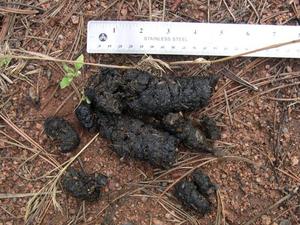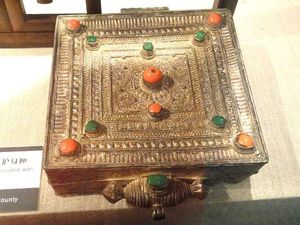Identifying bear feces can be of valuable importance whether you are hiking, camping, or if you live in an area close to bear habitat. Bear feces is typically found black on the surface and can be 2 to 4 inches in length and from one to two inches in diameter depending on the size of the bear itself. It is difficult at best to identify if the bear is a black bear or a Grizzly since their feces is very similar, typically the Grizzly feces may be a little larger than that of a small black bear however this is not always a reliable method. We live in the Southern Rockies near Colorado Springs and Grizzly bears are not typically indigenous to this area so when we spot signs of bear in our area, we can be fairly sure that it belongs to a black bear.
The first step in identifying bear feces is to understand that a bears diet changes with the seasons. Black bears are predatory but they also forage and love berries, insects, and bird feeders, (see images for more detail). During the early season after waking from hibernation, there are not yet many berries in the mountains for them to forage on, so they will eat squirrel and other game they might be able to prey upon or they may possibly scavenge. Bears will also eat what they can find in unsecured garbage cans and unlocked dumpsters. Bears are opportunists and will take advantage of just about anything they can draw some nutrition from. As summer begins to fade and the berries begin to ripen, black bears will begin foraging heavily on berries and sweets in order to start putting on fat reservoirs for the winter.
By identifying bear feces you can tell what type of diet they are eating and this also helps in identifying that it did indeed come from a bear. During the early season, by breaking it open with a stick, you may find animal fur and possibly even find some garbage remnants like a little plastic or part of a wrapper from something they found in the trash, however this is rare. Later in the season when they add berries to their diets, you will begin finding little seeds from the berries. This is a dead give away, and generally you will see the seeds peppered on the surface of the feces so it is not necessary to dig too deeply to see that the berries have ripened and the bears are beginning their preparation for winter.
Knowing this information is important for safety when hiking and when living in their territory, as being forewarned is being fore armed. It is also important to know that bears can run quite rapidly, in fact about 35 miles per hour. This means if you see a bear a half a football field away and you feel this to be a safe distance, just remember that the bear can cover 50 yards of ground in about 3 seconds. If there are three of four people standing near a door where you can seek shelter and you are watching a bear 50 yards away, if that bear decided to charge you, it is quite likely he can reach you before all of you can get inside and secure the door.
Identifying bear feces gives a warning to you that bears frequent the area but typically bears do not attack humans and most will actually leave the area when they hear people, but if it is at night and they are eating, or if they have a baby near by, or even possibly in the case of a black bear they may see you as a food source, they can attack. Grizzly bears typically attack from people walking up on them unnoticed and they are startled, but black bears can attack out of predatory behavior, in other words he may see you as a potential food source. The photo’s I have included with this article show a Black Bears droppings in a vacant camping spot right across the drive about 20 yards from our spot. This was spotted fresh, the bear had been here the night before, and the droppings from this bear are quite large meaning this is probably a very large black bear. In subsequent pictures you can see where I waited for a couple days and a couple rains to break it apart and reveal some of it’s contents. We found no fur in this dropping, but you can see the bear apparently raided someones bird feeder, ate some insects, and a pine cone, (pine cones have pine nuts in them and most of the pine nuts are edible, but in another picture you can see by the ruler next to it that this is a fairly large dropping and most likely from a fairly large adult.


